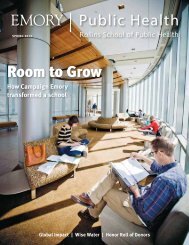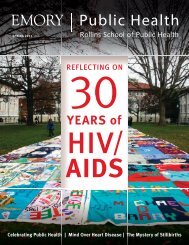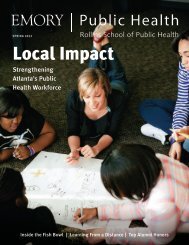returning quality to life - Woodruff Health Sciences Center - Emory ...
returning quality to life - Woodruff Health Sciences Center - Emory ...
returning quality to life - Woodruff Health Sciences Center - Emory ...
You also want an ePaper? Increase the reach of your titles
YUMPU automatically turns print PDFs into web optimized ePapers that Google loves.
Rising from the ashes<br />
The public health situation was quite different in<br />
Guinea-Bissau than in Bangladesh. One of the poorest<br />
countries in the world, with an average <strong>life</strong> expectancy of 40.5<br />
years, this West African nation had nonetheless managed <strong>to</strong> build a<br />
small but functioning public health system by the late 1990s. Then,<br />
everything vanished.<br />
Caught in a bitter civil war, the majority of health professionals<br />
fled the country, never <strong>to</strong> return. The national reference labora<strong>to</strong>ry,<br />
the pride of the health system, <strong>to</strong>ok direct hits from two bombs.<br />
Basic public health measures, such as the vaccination of children,<br />
dropped precipi<strong>to</strong>usly, and Guinea-Bissau was left with no way <strong>to</strong><br />
address continuing health problems like malaria, tuberculosis, and<br />
HIV/AIDS. After the war ended, the significance of not having a<br />
working public health structure was highlighted when a cholera<br />
outbreak swept the devastated country, killing hundreds and<br />
sickening thousands more. International agencies rushed in <strong>to</strong> put<br />
out the fire of epidemic, but no one on the ground was adequately<br />
prepared <strong>to</strong> identify the outbreak’s cause, track its spread, or take<br />
measures <strong>to</strong> prevent its return.<br />
Guinea-Bissau’s lack of a national public health institute was<br />
IANPHI helped Guinea-<br />
Bissau rebuild a public<br />
health labora<strong>to</strong>ry and a<br />
shattered public health<br />
infrastructure destroyed in<br />
civil war.<br />
tailor-made for IANPHI’s goals. With specialized help from two<br />
IANPHI members (Brazil’s FIOCRUZ and Portugal’s Institute of<br />
Hygiene and Tropical Medicine), the association jumped in <strong>to</strong><br />
help Guinea-Bissau bring <strong>to</strong>gether its disparate programs in<strong>to</strong> a<br />
centralized public health institute. With its own and leveraged<br />
funds, the country rebuilt and outfitted the destroyed headquarters<br />
and lab, adding new genera<strong>to</strong>rs <strong>to</strong> res<strong>to</strong>re electricity and water. A<br />
national school of public health was integrated in<strong>to</strong> the reconfigured<br />
institute and additional programs <strong>to</strong> train public health staff, nurses,<br />
midwives, and lab technicians were added <strong>to</strong> replace those who<br />
had left during the war. A new countrywide surveillance program,<br />
incorporating lap<strong>to</strong>ps and cell phones, has since shortened response<br />
time <strong>to</strong> cholera and other outbreaks from weeks <strong>to</strong> days.<br />
Rebuilding Guinea-Bissau’s shattered public health<br />
infrastructure would not have been possible without IANPHI,<br />
says Amabelia Rodrigues, president of the country’s new National<br />
Institute of Public <strong>Health</strong>. “What we want <strong>to</strong> show the world<br />
now is that it is possible, even in very poor countries, even in the<br />
most adverse situations, <strong>to</strong> develop a good <strong>quality</strong> public health<br />
system.”<br />
Winter 2011 11
















